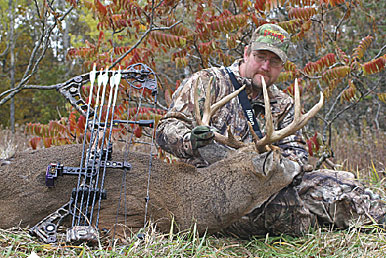Fall food plots for deer
FALL FOOD PLOTS FOR DEER VS SPRING FOOD PLOTS
Before we get into fall food plot strategies, we need to differentiate them from spring plots. There’s certainly more than one way to skin a cat with food plots. Still, having consulted for many top outfitters and private landowners, I’ve found the following approach to be more effective than anything else I’ve tried.
According to my plan, spring plots are all about providing deer a surplus of highly nutritious feed and holding them on the property. To accomplish this, spring plots must be rather large, typically 4-10 acres in size.
Also, because they are designed for nutrition and holding deer, they should be located in areas where deer will feel safe. After all, the more they eat, the more they will benefit from the nutrition your plot offers. Also, if the deer don’t feel safe where the plot is located, they will likely wander to the neighbor’s.
Still, it’s alright if spring plots are located in slightly more open areas and if most of the feeding occurs after dark.
As spring plots are primarily designed for holding and feeding deer, fall plots are often designed for killing them. Their ultimate purpose is to create staging areas for deer as they travel to bed or to their primary food sources before night falls.
Why spend so much time discussing spring food plots in a fall food plot article? As you’ll soon see, though they serve different purposes, the two should work in concert with each other. Frankly, that’s a huge part of getting the maximum benefit out of fall food plots.
PLACE YOUR PITCHES WITH FALL FOOD PLOTS FOR DEER
Of course, many factors go into determining the precise location of a food plot, and fall plots are no different. At a minimum, the area selected should receive four hours of direct sunlight a day. Sure, many “no plow” varieties claim to produce with less, but none I’ve tried have produced well enough to cover in good faith.
The author caught this old Minnesota 8-pointer tending a scrape on the edge of an Antler King food plot. Photo courtesy of Steve Bartylla.
Soil type and quality is also an important consideration. You will almost never get the results from a sandy hill top that a fertile bottom can produce. All else being equal, a bottom that is always wet won’t produce nearly as well as a fast-draining flat. One must select areas that are capable of growing a thriving food plot, or they start with the odds stacked against them.
Fall food plots work best when placed between bedding areas and primary food sources. Doing so is the first step in getting the bucks to stage there during daylight.
A great example of this is how I set up a lease I had a few years back. My small lease was dominated by thick, nasty brush land that butted against large crop fields. I rented a bulldozer for a couple days work, and I cleared four openings, each about 100 yards back from the main fields.
Though their proximity to each other varied, they were all at least 200 yards apart. Therein lies another game one can play with fall food plots. Outside of the rut, bucks are tolerant of each other. During the rut, mature bucks can be hell-bent on killing each other, with the dominant buck often being very intolerant of other mature bucks.
Mature bucks rarely change their true home range because of competition. However, they certainly will — and often do — spend far more time in the portions of their home range where they can play ruler. Dividing up both spring and fall plots can help the hunter keep more mature bucks on their property than if there was just one main food source.
This could be seen clearly on my lease. Despite the overall area not holding many mature bucks, my 200-acre lease had a clean 4 1/2-year-old 10–pointer and a 5 1/2-year-old mainframe 10-pointer with matching split G2s. Both bucks spent the majority of their time on my 200 acres. The 5 1/2-year-old was clearly the dominant buck, and I got numerous pictures of him in three of the fall food plots. Once the rut neared and a snapped G3 revealed a fight, the 4.5 year old limited his activities to the only plot the elder ignored. That food plot strategy allowed them to coexist much more peacefully, and it allowed me to keep two mature bucks on my property.
Still, the greatest advantage of the isolated plots was daytime deer movement. As neighboring hunters so often do, a stand was set right on the property line where the field began. Ranging it from my stand, it was exactly 108 yards away. Despite hunting the fence stand hard, the hunter ate his tag that season, reportedly passing up only a single 1 1/2-year-old buck. I understood his focus on that stand. He had numerous night time trail camera shots of the two mature bucks I was hunting.
Still, just 108 yards away, I passed more than one buck in almost every sit, until I eventually arrowed the 4 1/2-year-old 10-pointer. That’s how much difference a well though-out fall plot location can have on your season. If mature bucks feel safe in a given setting, they will be willing to move there during daylight.
Unfortunately, most hunters don’t have access to bulldozers to clear land for food plots. Renting, as I did, is an option for do-it-yourselfers. Another is contracting a bulldozer operator for a day. A skilled operator can push out several plots in a day, and their rates can be surprisingly low.
Another option is hitting the woods with a chainsaw. Remember, we aren’t cash cropping here. So, having stumps in the plot just means you disc around them. Doing it this way takes more time, but having used this technique more than I’d care to remember, it certainly can be done.
If that’s still too much work, at least situate your food plots in the inside corners of fields or any other location that are partially protected. In areas with corn or sorghum fields, one can often put the fall plot in the back corner and leave a 50-yard wide buffer of standing crops to create a privacy fence. Be creative, and possibilities will abound.
SIZING AND SHAPING FOR THE KILL
Of course, you want to have shot opportunities at every deer that enters your fall plot. After all, mature bucks rarely offer second chances. If you see him once during legal light, you want to kill him right then. That’s where the size and shape of your fall food plot come into play.
Except in odd circumstances, almost every fall plot I implement is between a half-acre and one acre in size. Assuming other, bigger feeding plots are available, this is typically big enough to withstand feeding through the season but small enough to make bucks feel secure. However, the planting must be a high forage producer. That size is just too small for grain crops, even when double planted.
When creating the opening, shape your plot as an “L,” approximately 30 yards wide. The length of both straights is flexible, but a plot less than 30 yards wide will likely get too little sunlight. Next, try to situate the inside corner of the elbow so that the area’s most common prevailing fall wind blows out to the feed plot and away from the fall plot. Doing so allows for stands to be placed on both the inside and outside corners of the elbow, allowing for safe hunting in the majority of winds.
The shape of the plot is important. Mature bucks entering the plot want to be able to take inventory of the deer out there, and they’ll want to see as much of the plot as they can. Because of that, they gravitate to the elbow and keep an eye on both straights.
When one is forced to put in square or rectangular fall plots, even a half-acre allows a surprisingly high percentage of deer to stay out of shooting range. It sounds good to tell yourself you’ll call Mr. Big over for the shot, but being surrounded by other deer often makes that impractical.
Luckily, “planting” a scrape tree 20 yards out into the plot radically ups the opportunity rate. Simply cut a suitable tree with a diameter between that of a soda and small coffee can. Use a posthole digger to dig a 2- to 3-foot hole and “plant” the tree, packing it in solid. Cut the branches so that several are around nose level to deer and pointing towards the stand.
What I didn’t mention is that I’d had close calls with the old 8-pointer three other times on that food plot, but he kept entering from different directions. After I hung the new stand that afternoon, I cut and planted a small oak 20 yards in front of my stand. The tree stuck out like a sore thumb, and two other small bucks had already made scrapes under it that afternoon before the old-timer appeared. Approaching from the opposite side, he marched across the entire food plot to make a scrape under this new tree. As he began, I changed his plans for him. That’s a great trick for convincing bucks to expose themselves in fall plots.
CONCLUSION ON FALL FOOD PLOTS FOR DEER
Fall food plots truly can be difference-makers. When designed to create natural staging areas, provide the illusion of safety and expose deer, fall food plots can produce some serious results!


